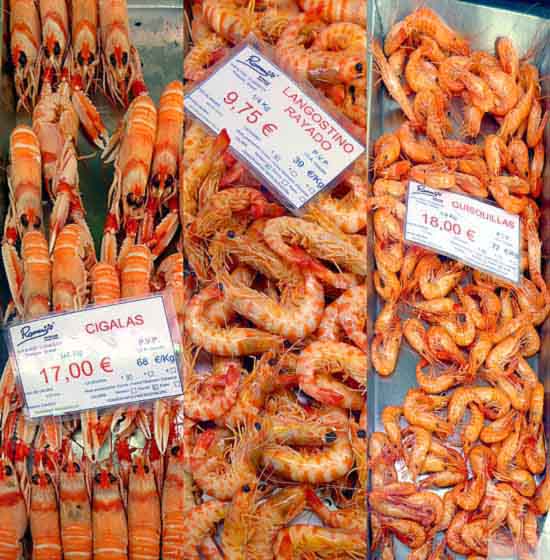
Few things are as quite as confusing as the wonderful array of crustaceans available in southern Spain. When we were in El Puerto de Santa María in February, we photographed some of them at the Romerijo fish market (www.romerijo.com). The same crustacean (per its Latin name) may have two or three different common names, depending on size and where it is caught. The six images here, for example, only show four different species.
Here they are, from left to right, above:
Camarón (Palaemon serratus) is the common rock shrimp (common prawn to the Brits) found in abundance at the mouth of the Río Guadalquivír. When they are small like this, they are comparatively inexpensive. In Andalucía, they are often fried up, shell and all, in a paper-thin omelet called a tortallita de camarones.
Langostino Sanlúcar (Penaeus kerathurus) is not what the French call langoustine or the Italians call scampi. In Spain it’s a large brown prawn with hints of red. Those from Sanlúcar are especially prized because they are sweeter and more tender than langostinos from other waters. They are usually steamed or grilled with olive oil and garlic.
Gamba blanca (Parapenaeus longirostris) is the North African white shrimp, which is often found in the Bay of Cádiz. It’s an especially meaty shrimp and is served in lieu of the carabinero (red prawn, scarlet prawn) fished in a different season.

Here’s the second group, from left to right, above:
Cigala (Nephrops noreugicus) is the French langoustine or the Italian scampi. It also goes by such monikers as Norway lobster or Dublin Bay prawn. It’s actually a member of the lobster family. In Spain, it’s usually cut in half lengthwise and grilled (a la plancha).
Langostino rayado (Penaeus kerathurus) is the same beast as the langostino Sanlúcar, but barely half the size. These were actually fished off the coast of Mauritania in northwest Africa. At this size they’re often used in baked rice dishes, such as paella de mariscos.
Quisquilla is a name applied, alas, to a couple of different shrimp or prawns. Often it’s the small brown shrimp that is mixed into rice dishes or into soups. Here it is a much bigger version of Palaemon serratus, the camarón and would be served steamed or pan-fried with garlic.
As confusing as the nomenclature may be, they all make terrific eating. At Romerijo, you can order them by weight and have them cooked immediately to eat on the spot. The fish market cum restaurant is located at Plaza de la Herrería, 1 in El Puerto de Santa María. The local telephone is 956-54-12-54.
